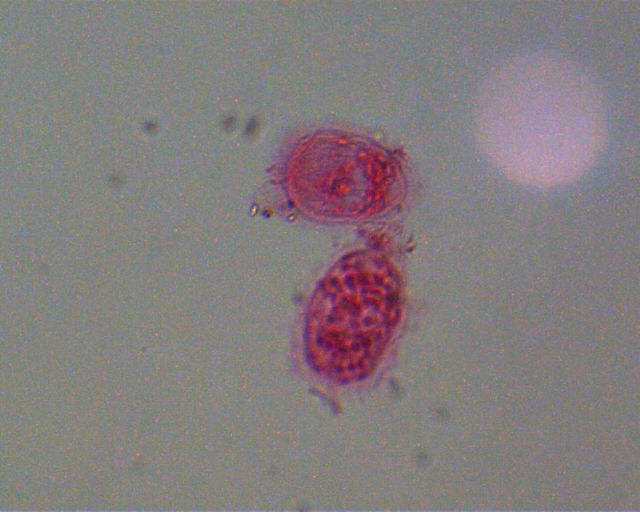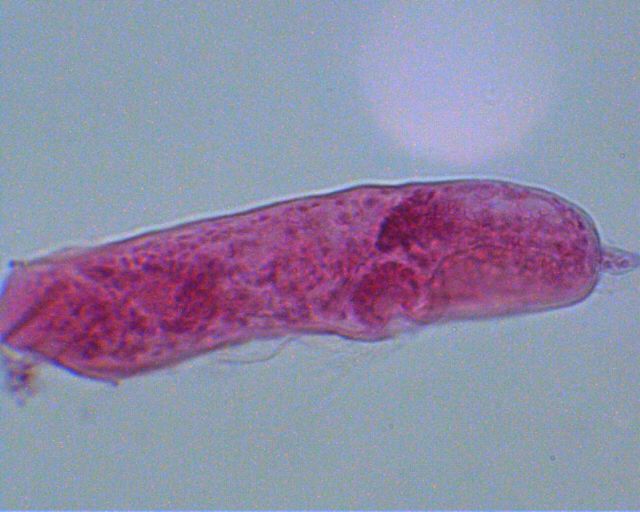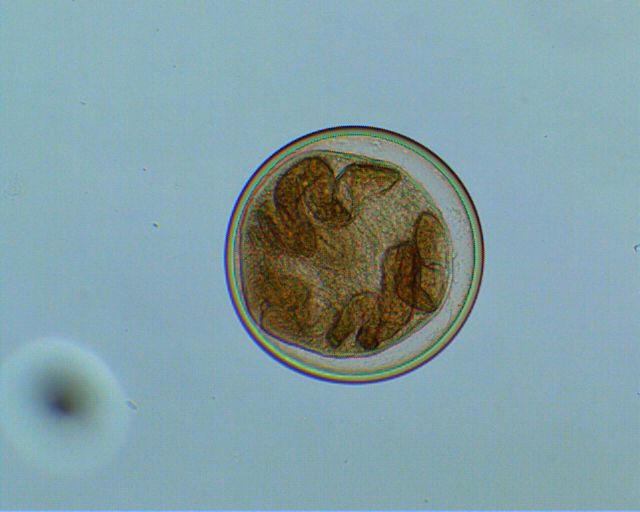Form and Function
Paragonimus westermani has four major forms
that should be considered. The first is the miricidia
(free-living larva), the second is the cercaria (or larval
worm), the third is the metacercaria (encysted worm), and the
final is the adult fluke. Each form has unique
characteristics and fascinating adaptations that allow it to
thrive in each of the species’ several hosts.
The miricidia is the smallest form. It hatches from the egg in an auquatic environment, and uses its cilia to swim to its first host, the freshwater snail (Liu et al. 2008). There is not much information about the specific physical features of P. westermani miricadia, but the larger group digenea miricidia have an anterior opening leading to penetration ducts within, and a posterior region that contains structures that will aid in asexual reproduction later in life (Animal Diversity Web 2012).
Once inside their first
intermediate host (Paludomus snails), the miricidia grow into
cercaria and
are
174.5 um in length and 73.2 um in width on average. The cercaria is
oval shaped, has a sucker on one end, and a flagellate tail for
locomotion on the other (Iwagami et al. 2007).
The metacercaria can live in several second intermediate hosts (freshwater crabs, crayfish), are oval shaped, can be thick or thin walled, and are larger than the cercariae (between 724 and 916 um in length, and between 598 and 771 um in width). The metacercariae can infect the muscles, hepatopancreas, and gills of the crabs (Rekah Devi et al. 2012). The metacercariae do not move, and once in the crab, they encyst (form a tough layer) around themselves. They each contain a single worm that will become the adult fluke in the definitive host (mammals). The metacercariae find their way to human (and other mammal) hosts when the mammal ingests the raw meat of infected crabs, boars, or sometimes (rarely) crayfish (Kuk-Na, et al. 2005).
Once inside the definitive mammal host, the metacercaria excysts
(comes out of its cyst). The newly emerged metacercaria then does
something very interesting. It begins secreting an enzyme that
allows it to: evade the host immune system, intake nutrients from
the host body, and dissolve the host tissue to aid in the movement
of the metacercaria (Kuk-Na, et al. 2005). The metacercaria
then begins traveling directly through the host intestines until it
reaches the lungs. Once in the lungs, it forms a thick fibrous layer
around itself, and begins developing into an adult fluke. (Rekha
Devi et al. 2012).
The adult fluke is mostly flat and ovoid in shape, between ~6 -7mm
in length, and between ~4-5 mm in width. The fluke has two suckers,
one oral and
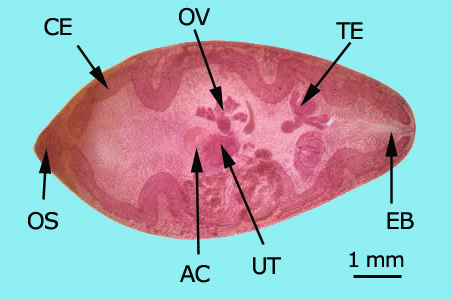 one ventral (belly). The skin is covered in spines, and
eggs laid by the fluke were dark brown in color (Rekha Devi et
al. 2009). Perhaps the most interesting adaptation displayed by
the adult fluke is its ability to thrive in both low oxygen and high
oxygen environments. This adaptaion is necessary because (as
previously stated) the fluke can end up not only in the lungs, but
in many low-oxygen environments in the host body. The fluke can do
this because it actually has three distinct populations
of mitochondria! Each population serves to produce ATP most
efficiently in different environments. (Takamiya et al,
2010). For another organism that employs INCREDIBLE adaptations
to survive hostile environments, see
this page.
one ventral (belly). The skin is covered in spines, and
eggs laid by the fluke were dark brown in color (Rekha Devi et
al. 2009). Perhaps the most interesting adaptation displayed by
the adult fluke is its ability to thrive in both low oxygen and high
oxygen environments. This adaptaion is necessary because (as
previously stated) the fluke can end up not only in the lungs, but
in many low-oxygen environments in the host body. The fluke can do
this because it actually has three distinct populations
of mitochondria! Each population serves to produce ATP most
efficiently in different environments. (Takamiya et al,
2010). For another organism that employs INCREDIBLE adaptations
to survive hostile environments, see
this page. 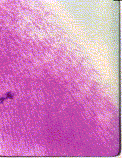
OS: oral sucker CE: cecum OV:
ovary TE: testes EB: excretory bladder
UT: uterus AC: acetabulum (ventral sucker)
Continue to:
Reproduction/Lifecycle
Return to: Home Page
References
